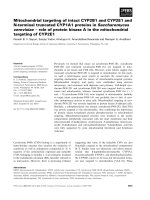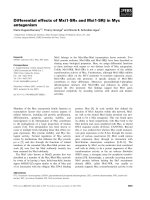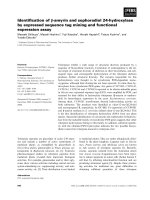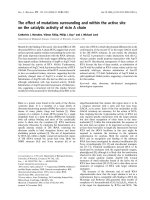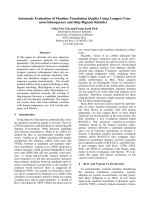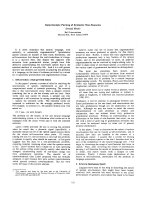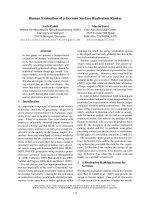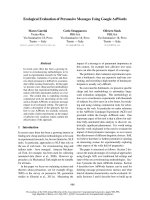Báo cáo khoa học: "Task-oriented Evaluation of Syntactic Parsers and Their Representations" potx
Bạn đang xem bản rút gọn của tài liệu. Xem và tải ngay bản đầy đủ của tài liệu tại đây (342.91 KB, 9 trang )
Proceedings of ACL-08: HLT, pages 46–54,
Columbus, Ohio, USA, June 2008.
c
2008 Association for Computational Linguistics
Task-oriented Evaluation of Syntactic Parsers and Their Representations
Yusuke Miyao
†
Rune Sætre
†
Kenji Sagae
†
Takuya Matsuzaki
†
Jun’ichi Tsujii
†‡∗
†
Department of Computer Science, University of Tokyo, Japan
‡
School of Computer Science, University of Manchester, UK
∗
National Center for Text Mining, UK
{yusuke,rune.saetre,sagae,matuzaki,tsujii}@is.s.u-tokyo.ac.jp
Abstract
This paper presents a comparative evalua-
tion of several state-of-the-art English parsers
based on different frameworks. Our approach
is to measurethe impact of each parser when it
is used as a component of an information ex-
traction system that performs protein-protein
interaction (PPI) identification in biomedical
papers. We evaluate eight parsers (based on
dependency parsing, phrase structure parsing,
or deep parsing) using five different parse rep-
resentations. We run a PPI system with several
combinations of parser and parse representa-
tion, and examine their impact on PPI identi-
fication accuracy. Our experiments show that
the levels of accuracy obtained with these dif-
ferent parsers are similar, but that accuracy
improvements vary when the parsers are re-
trained with domain-specific data.
1 Introduction
Parsing technologies have improved considerably in
the past few years, and high-performance syntactic
parsers are no longer limited to PCFG-based frame-
works (Charniak, 2000; Klein and Manning, 2003;
Charniak and Johnson, 2005; Petrov and Klein,
2007), but also include dependency parsers (Mc-
Donald and Pereira, 2006; Nivre and Nilsson, 2005;
Sagae and Tsujii, 2007) and deep parsers (Kaplan
et al., 2004; Clark and Curran, 2004; Miyao and
Tsujii, 2008). However, efforts to perform extensive
comparisons of syntactic parsers based on different
frameworks have been limited. The most popular
method for parser comparison involves the direct
measurement of the parser output accuracy in terms
of metrics such as bracketing precision and recall, or
dependency accuracy. This assumes the existence of
a gold-standard test corpus, such as the Penn Tree-
bank (Marcus et al., 1994). It is difficult to apply
this method to compare parsers based on different
frameworks, because parse representations are often
framework-specific and differ from parser to parser
(Ringger et al., 2004). The lack of such comparisons
is a serious obstacle for NLP researchers in choosing
an appropriate parser for their purposes.
In this paper, we present a comparative evalua-
tion of syntactic parsers and their output represen-
tations based on different frameworks: dependency
parsing, phrase structure parsing, and deep pars-
ing. Our approach to parser evaluation is to mea-
sure accuracy improvement in the task of identify-
ing protein-protein interaction (PPI) information in
biomedical papers, by incorporating the output of
different parsers as statistical features in a machine
learning classifier (Yakushiji et al., 2005; Katrenko
and Adriaans, 2006; Erkan et al., 2007; Sætre et al.,
2007). PPI identification is a reasonable task for
parser evaluation, because it is a typical information
extraction (IE) application, and because recent stud-
ies have shown the effectiveness of syntactic parsing
in this task. Since our evaluation method is applica-
ble to any parser output, and is grounded in a real
application, it allows for a fair comparison of syn-
tactic parsers based on different frameworks.
Parser evaluation in PPI extraction also illu-
minates domain portability. Most state-of-the-art
parsers for English were trained with the Wall Street
Journal (WSJ) portion of the Penn Treebank, and
high accuracy has been reported for WSJ text; how-
ever, these parsers rely on lexical information to at-
tain high accuracy, and it has been criticized that
these parsers may overfit to WSJ text (Gildea, 2001;
46
Klein and Manning, 2003). Another issue for dis-
cussion is the portability of training methods. When
training data in the target domain is available, as
is the case with the GENIA Treebank (Kim et al.,
2003) for biomedical papers, a parser can be re-
trained to adapt to the target domain, and larger ac-
curacy improvements are expected, if the training
method is sufficiently general. We will examine
these two aspects of domain portability by compar-
ing the original parsers with the retrained parsers.
2 Syntactic Parsers and Their
Representations
This paper focuses on eight representative parsers
that are classified into three parsing frameworks:
dependency parsing, phrase structure parsing, and
deep parsing. In general, our evaluation methodol-
ogy can be applied to English parsers based on any
framework; however, in this paper, we chose parsers
that were originally developed and trained with the
Penn Treebank or its variants, since such parsers can
be re-trained with GENIA, thus allowing for us to
investigate the effect of domain adaptation.
2.1 Dependency parsing
Because the shared tasks of CoNLL-2006 and
CoNLL-2007 focused on data-driven dependency
parsing, it has recently been extensively studied in
parsing research. The aim of dependency pars-
ing is to compute a tree structure of a sentence
where nodes are words, and edges represent the re-
lations among words. Figure 1 shows a dependency
tree for the sentence “IL-8 recognizes and activates
CXCR1.” An advantage of dependency parsing is
that dependency trees are a reasonable approxima-
tion of the semantics of sentences, and are readily
usable in NLP applications. Furthermore, the effi-
ciency of popular approaches to dependency pars-
ing compare favorable with those of phrase struc-
ture parsing or deep parsing. While a number of ap-
proaches have been proposed for dependency pars-
ing, this paper focuses on two typical methods.
MST McDonald and Pereira (2006)’s dependency
parser,
1
based on the Eisner algorithm for projective
dependency parsing (Eisner, 1996) with the second-
order factorization.
1
/>Figure 1: CoNLL-X dependency tree
Figure 2: Penn Treebank-style phrase structure tree
KSDEP Sagae and Tsujii (2007)’s dependency
parser,
2
based on a probabilistic shift-reduce al-
gorithm extended by the pseudo-projective parsing
technique (Nivre and Nilsson, 2005).
2.2 Phrase structure parsing
Owing largely to the Penn Treebank, the mainstream
of data-driven parsing research has been dedicated
to the phrase structure parsing. These parsers output
Penn Treebank-style phrase structure trees, although
function tags and empty categories are stripped off
(Figure 2). While most of the state-of-the-art parsers
are based on probabilistic CFGs, the parameteriza-
tion of the probabilistic model of each parser varies.
In this work, we chose the following four parsers.
NO-RERANK Charniak (2000)’s parser, based on a
lexicalized PCFG model of phrase structure trees.
3
The probabilities of CFG rules are parameterized on
carefully hand-tuned extensive information such as
lexical heads and symbols of ancestor/sibling nodes.
RERANK Charniak and Johnson (2005)’s rerank-
ing parser. The reranker of this parser receives n-
best
4
parse results from NO-RERANK, and selects
the most likely result by using a maximum entropy
model with manually engineered features.
BERKELEY Berkeley’s parser (Petrov and Klein,
2007).
5
The parameterization of this parser is op-
2
/>3
/>4
We set n = 50 in this paper.
5
/>47
Figure 3: Predicate argument structure
timized automatically by assigning latent variables
to each nonterminal node and estimating the param-
eters of the latent variables by the EM algorithm
(Matsuzaki et al., 2005).
STANFORD Stanford’s unlexicalized parser (Klein
and Manning, 2003).
6
Unlike NO-RERANK, proba-
bilities are not parameterized on lexical heads.
2.3 Deep parsing
Recent research developments have allowed for ef-
ficient and robust deep parsing of real-world texts
(Kaplan et al., 2004; Clark and Curran, 2004; Miyao
and Tsujii, 2008). While deep parsers compute
theory-specific syntactic/semantic structures, pred-
icate argument structures (PAS) are often used in
parser evaluation and applications. PAS is a graph
structure that represents syntactic/semantic relations
among words (Figure 3). The concept is therefore
similar to CoNLL dependencies, though PAS ex-
presses deeper relations, and may include reentrant
structures. In this work, we chose the two versions
of the Enju parser (Miyao and Tsujii, 2008).
ENJU The HPSG parser that consists of an HPSG
grammar extracted from the Penn Treebank, and
a maximum entropy model trained with an HPSG
treebank derived from the Penn Treebank.
7
ENJU-GENIA The HPSG parser adapted to
biomedical texts, by the method of Hara et al.
(2007). Because this parser is trained with both
WSJ and GENIA, we compare it parsers that are
retrained with GENIA (see section 3.3).
3 Evaluation Methodology
In our approach to parser evaluation, we measure
the accuracy of a PPI extraction system, in which
6
/>shtml
7
/>This study demonstrates that IL-8 recognizes and
activates CXCR1, CXCR2, and the Duffy antigen
by distinct mechanisms.
The molar ratio of serum retinol-binding protein
(RBP) to transthyretin (TTR) is not useful to as-
sess vitamin A status during infection in hospi-
talised children.
Figure 4: Sentences including protein names
ENTITY1(IL-8)
SBJ
−→ recognizes
OBJ
←− ENTITY2(CXCR1)
Figure 5: Dependency path
the parser output is embedded as statistical features
of a machine learning classifier. We run a classi-
fier with features of every possible combination of a
parser and a parse representation, by applying con-
versions between representations when necessary.
We also measure the accuracy improvements ob-
tained by parser retraining with GENIA, to examine
the domain portability, and to evaluate the effective-
ness of domain adaptation.
3.1 PPI extraction
PPI extraction is an NLP task to identify protein
pairs that are mentioned as interacting in biomedical
papers. Because the number of biomedical papers is
growing rapidly, it is impossible for biomedical re-
searchers to read all papers relevant to their research;
thus, there is an emerging need for reliable IE tech-
nologies, such as PPI identification.
Figure 4 shows two sentences that include pro-
tein names: the former sentence mentions a protein
interaction, while the latter does not. Given a pro-
tein pair, PPI extraction is a task of binary classi-
fication; for example, IL-8, CXCR1 is a positive
example, and RBP, TTR is a negative example.
Recent studies on PPI extraction demonstrated that
dependency relations between target proteins are ef-
fective features for machine learning classifiers (Ka-
trenko and Adriaans, 2006; Erkan et al., 2007; Sætre
et al., 2007). For the protein pair IL-8 and CXCR1
in Figure 4, a dependency parser outputs a depen-
dency tree shown in Figure 1. From this dependency
tree, we can extract a dependency path shown in Fig-
ure 5, which appears to be a strong clue in knowing
that these proteins are mentioned as interacting.
48
(dep_path (SBJ (ENTITY1 recognizes))
(rOBJ (recognizes ENTITY2)))
Figure 6: Tree representation of a dependency path
We follow the PPI extraction method of Sætre et
al. (2007), which is based on SVMs with SubSet
Tree Kernels (Collins and Duffy, 2002; Moschitti,
2006), while using different parsers and parse rep-
resentations. Two types of features are incorporated
in the classifier. The first is bag-of-words features,
which are regarded as a strong baseline for IE sys-
tems. Lemmas of words before, between and after
the pair of target proteins are included, and the linear
kernel is used for these features. These features are
commonly included in all of the models. Filtering
by a stop-word list is not applied because this setting
made the scores higher than Sætre et al. (2007)’s set-
ting. The other type of feature is syntactic features.
For dependency-based parse representations, a de-
pendency path is encoded as a flat tree as depicted in
Figure 6 (prefix “r” denotes reverse relations). Be-
cause a tree kernel measures the similarity of trees
by counting common subtrees, it is expected that the
system finds effective subsequences of dependency
paths. For the PTB representation, we directly en-
code phrase structure trees.
3.2 Conversion of parse representations
It is widely believed that the choice of representa-
tion format for parser output may greatly affect the
performance of applications, although this has not
been extensively investigated. We should therefore
evaluate the parser performance in multiple parse
representations. In this paper, we create multiple
parse representations by converting each parser’s de-
fault output into other representations when possi-
ble. This experiment can also be considered to be
a comparative evaluation of parse representations,
thus providing an indication for selecting an appro-
priate parse representation for similar IE tasks.
Figure 7 shows our scheme for representation
conversion. This paper focuses on five representa-
tions as described below.
CoNLL The dependency tree format used in the
2006 and 2007 CoNLL shared tasks on dependency
parsing. This is a representation format supported by
several data-driven dependency parsers. This repre-
Figure 7: Conversion of parse representations
Figure 8: Head dependencies
sentation is also obtained from Penn Treebank-style
trees by applying constituent-to-dependency conver-
sion
8
(Johansson and Nugues, 2007). It should be
noted, however, that this conversion cannot work
perfectly with automatic parsing, because the con-
version program relies on function tags and empty
categories of the original Penn Treebank.
PTB Penn Treebank-style phrase structure trees
without function tags and empty nodes. This is the
default output format for phrase structure parsers.
We also create this representation by converting
ENJU’s output by tree structure matching, although
this conversion is not perfect because forms of PTB
and ENJU’s output are not necessarily compatible.
HD Dependency trees of syntactic heads (Fig-
ure 8). This representation is obtained by convert-
ing PTB trees. We first determine lexical heads of
nonterminal nodes by using Bikel’s implementation
of Collins’ head detection algorithm
9
(Bikel, 2004;
Collins, 1997). We then convert lexicalized trees
into dependencies between lexical heads.
SD The Stanford dependency format (Figure 9).
This format was originally proposed for extracting
dependency relations useful for practical applica-
tions (de Marneffe et al., 2006). A program to con-
vert PTB is attached to the Stanford parser. Although
the concept looks similar to CoNLL, this representa-
8
/>9
/>html
49
Figure 9: Stanford dependencies
tion does not necessarily form a tree structure, and is
designed to express more fine-grained relations such
as apposition. Research groups for biomedical NLP
recently adopted this representation for corpus anno-
tation (Pyysalo et al., 2007a) and parser evaluation
(Clegg and Shepherd, 2007; Pyysalo et al., 2007b).
PAS Predicate-argument structures. This is the de-
fault output format for ENJU and ENJU-GENIA.
Although only CoNLL is available for depen-
dency parsers, we can create four representations for
the phrase structure parsers, and five for the deep
parsers. Dotted arrows in Figure 7 indicate imper-
fect conversion, in which the conversion inherently
introduces errors, and may decrease the accuracy.
We should therefore take caution when comparing
the results obtained by imperfect conversion. We
also measure the accuracy obtained by the ensem-
ble of two parsers/representations. This experiment
indicates the differences and overlaps of information
conveyed by a parser or a parse representation.
3.3 Domain portability and parser retraining
Since the domain of our target text is different from
WSJ, our experiments also highlight the domain
portability of parsers. We run two versions of each
parser in order to investigate the two types of domain
portability. First, we run the original parsers trained
with WSJ
10
(39832 sentences). The results in this
setting indicate the domain portability of the original
parsers. Next, we run parsers re-trained with GE-
NIA
11
(8127 sentences), which is a Penn Treebank-
style treebank of biomedical paper abstracts. Accu-
racy improvements in this setting indicate the pos-
sibility of domain adaptation, and the portability of
the training methods of the parsers. Since the parsers
listed in Section 2 have programs for the training
10
Some of the parser packages include parsing models
trained with extended data, but we used the models trained with
WSJ section 2-21 of the Penn Treebank.
11
The domains of GENIA and AImed are not exactly the
same, because they are collected independently.
with a Penn Treebank-style treebank, we use those
programs as-is. Default parameter settings are used
for this parser re-training.
In preliminary experiments, we found that de-
pendency parsers attain higher dependency accuracy
when trained only with GENIA. We therefore only
input GENIA as the training data for the retraining
of dependency parsers. For the other parsers, we in-
put the concatenation of WSJ and GENIA for the
retraining, while the reranker of RERANK was not re-
trained due to its cost. Since the parsers other than
NO-RERANK and RERANK require an external POS
tagger, a WSJ-trained POS tagger is used with WSJ-
trained parsers, and geniatagger (Tsuruoka et al.,
2005) is used with GENIA-retrained parsers.
4 Experiments
4.1 Experiment settings
In the following experiments, we used AImed
(Bunescu and Mooney, 2004), which is a popular
corpus for the evaluation of PPI extraction systems.
The corpus consists of 225 biomedical paper ab-
stracts (1970 sentences), which are sentence-split,
tokenized, and annotated with proteins and PPIs.
We use gold protein annotations given in the cor-
pus. Multi-word protein names are concatenated
and treated as single words. The accuracy is mea-
sured by abstract-wise 10-fold cross validation and
the one-answer-per-occurrence criterion (Giuliano
et al., 2006). A threshold for SVMs is moved to
adjust the balance of precision and recall, and the
maximum f-scores are reported for each setting.
4.2 Comparison of accuracy improvements
Tables 1 and 2 show the accuracy obtained by using
the output of each parser in each parse representa-
tion. The row “baseline” indicates the accuracy ob-
tained with bag-of-words features. Table 3 shows
the time for parsing the entire AImed corpus, and
Table 4 shows the time required for 10-fold cross
validation with GENIA-retrained parsers.
When using the original WSJ-trained parsers (Ta-
ble 1), all parsers achieved almost the same level
of accuracy — a significantly better result than the
baseline. To the extent of our knowledge, this is
the first result that proves that dependency parsing,
phrase structure parsing, and deep parsing perform
50
CoNLL PTB HD SD PAS
baseline 48.2/54.9/51.1
MST 53.2/56.5/54.6 N/A N/A N/A N/A
KSDEP 49.3/63.0/55.2 N/A N/A N/A N/A
NO-RERANK 50.7/60.9/55.2 45.9/60.5/52.0 50.6/60.9/55.1 49.9/58.2/53.5 N/A
RERANK 53.6/59.2/56.1 47.0/58.9/52.1 48.1/65.8/55.4 50.7/62.7/55.9 N/A
BERKELEY 45.8/67.6/54.5 50.5/57.6/53.7 52.3/58.8/55.1 48.7/62.4/54.5 N/A
STANFORD 50.4/60.6/54.9 50.9/56.1/53.0 50.7/60.7/55.1 51.8/58.1/54.5 N/A
ENJU 52.6/58.0/55.0 48.7/58.8/53.1 57.2/51.9/54.2 52.2/58.1/54.8 48.9/64.1/55.3
Table 1: Accuracy on the PPI task with WSJ-trained parsers (precision/recall/f-score)
CoNLL PTB HD SD PAS
baseline 48.2/54.9/51.1
MST 49.1/65.6/55.9 N/A N/A N/A N/A
KSDEP 51.6/67.5/58.3 N/A N/A N/A N/A
NO-RERANK 53.9/60.3/56.8 51.3/54.9/52.8 53.1/60.2/56.3 54.6/58.1/56.2 N/A
RERANK 52.8/61.5/56.6 48.3/58.0/52.6 52.1/60.3/55.7 53.0/61.1/56.7 N/A
BERKELEY 52.7/60.3/56.0 48.0/59.9/53.1 54.9/54.6/54.6 50.5/63.2/55.9 N/A
STANFORD 49.3/62.8/55.1 44.5/64.7/52.5 49.0/62.0/54.5 54.6/57.5/55.8 N/A
ENJU 54.4/59.7/56.7 48.3/60.6/53.6 56.7/55.6/56.0 54.4/59.3/56.6 52.0/63.8/57.2
ENJU-GENIA 56.4/57.4/56.7 46.5/63.9/53.7 53.4/60.2/56.4 55.2/58.3/56.5 57.5/59.8/58.4
Table 2: Accuracy on the PPI task with GENIA-retrained parsers (precision/recall/f-score)
WSJ-trained GENIA-retrained
MST 613 425
KSDEP 136 111
NO-RERANK 2049 1372
RERANK 2806 2125
BERKELEY 1118 1198
STANFORD 1411 1645
ENJU 1447 727
ENJU-GENIA 821
Table 3: Parsing time (sec.)
equally well in a real application. Among these
parsers, RERANK performed slightly better than the
other parsers, although the difference in the f-score
is small, while it requires much higher parsing cost.
When the parsers are retrained with GENIA (Ta-
ble 2), the accuracy increases significantly, demon-
strating that the WSJ-trained parsers are not suffi-
ciently domain-independent, and that domain adap-
tation is effective. It is an important observation that
the improvements by domain adaptation are larger
than the differences among the parsers in the pre-
vious experiment. Nevertheless, not all parsers had
their performance improved upon retraining. Parser
CoNLL PTB HD SD PAS
baseline 424
MST 809 N/A N/A N/A N/A
KSDEP 864 N/A N/A N/A N/A
NO-RERANK 851 4772 882 795 N/A
RERANK 849 4676 881 778 N/A
BERKELEY 869 4665 895 804 N/A
STANFORD 847 4614 886 799 N/A
ENJU 832 4611 884 789 1005
ENJU-GENIA 874 4624 895 783 1020
Table 4: Evaluation time (sec.)
retraining yielded only slight improvements for
RERANK, BERKELEY, and STANFORD, while larger
improvements were observed for MST, KSDEP, NO-
RERANK, and ENJU. Such results indicate the dif-
ferences in the portability of training methods. A
large improvement from ENJU to ENJU-GENIA shows
the effectiveness of the specifically designed do-
main adaptation method, suggesting that the other
parsers might also benefit from more sophisticated
approaches for domain adaptation.
While the accuracy level of PPI extraction is
the similar for the different parsers, parsing speed
51
RERANK ENJU
CoNLL HD SD CoNLL HD SD PAS
KSDEP CoNLL 58.5 (+0.2) 57.1 (−1.2) 58.4 (+0.1) 58.5 (+0.2) 58.0 (−0.3) 59.1 (+0.8) 59.0 (+0.7)
RERANK CoNLL 56.7 (+0.1) 57.1 (+0.4) 58.3 (+1.6) 57.3 (+0.7) 58.7 (+2.1) 59.5 (+2.3)
HD 56.8 (+0.1) 57.2 (+0.5) 56.5 (+0.5) 56.8 (+0.2) 57.6 (+0.4)
SD 58.3 (+1.6) 58.3 (+1.6) 56.9 (+0.2) 58.6 (+1.4)
ENJU CoNLL 57.0 (+0.3) 57.2 (+0.5) 58.4 (+1.2)
HD 57.1 (+0.5) 58.1 (+0.9)
SD 58.3 (+1.1)
Table 5: Results of parser/representation ensemble (f-score)
differs significantly. The dependency parsers are
much faster than the other parsers, while the phrase
structure parsers are relatively slower, and the deep
parsers are in between. It is noteworthy that the
dependency parsers achieved comparable accuracy
with the other parsers, while they are more efficient.
The experimental results also demonstrate that
PTB is significantly worse than the other represen-
tations with respect to cost for training/testing and
contributions to accuracy improvements. The con-
version from PTB to dependency-based representa-
tions is therefore desirable for this task, although it
is possible that better results might be obtained with
PTB if a different feature extraction mechanism is
used. Dependency-based representations are com-
petitive, while CoNLL seems superior to HD and SD
in spite of the imperfect conversion from PTB to
CoNLL. This might be a reason for the high per-
formances of the dependency parsers that directly
compute CoNLL dependencies. The results for ENJU-
CoNLL and ENJU-PAS show that PAS contributes to a
larger accuracy improvement, although this does not
necessarily mean the superiority of PAS, because two
imperfect conversions, i.e., PAS-to-PTB and PTB-to-
CoNLL, are applied for creating CoNLL.
4.3 Parser ensemble results
Table 5 shows the accuracy obtained with ensembles
of two parsers/representations (except the PTB for-
mat). Bracketed figures denote improvements from
the accuracy with a single parser/representation.
The results show that the task accuracy significantly
improves by parser/representation ensemble. Inter-
estingly, the accuracy improvements are observed
even for ensembles of different representations from
the same parser. This indicates that a single parse
representation is insufficient for expressing the true
Bag-of-words features 48.2/54.9/51.1
Yakushiji et al. (2005) 33.7/33.1/33.4
Mitsumori et al. (2006) 54.2/42.6/47.7
Giuliano et al. (2006) 60.9/57.2/59.0
Sætre et al. (2007) 64.3/44.1/52.0
This paper 54.9/65.5/59.5
Table 6: Comparison with previous results on PPI extrac-
tion (precision/recall/f-score)
potential of a parser. Effectiveness of the parser en-
semble is also attested by the fact that it resulted in
larger improvements. Further investigation of the
sources of these improvements will illustrate the ad-
vantages and disadvantages of these parsers and rep-
resentations, leading us to better parsing models and
a better design for parse representations.
4.4 Comparison with previous results on PPI
extraction
PPI extraction experiments on AImed have been re-
ported repeatedly, although the figures cannot be
compared directly because of the differences in data
preprocessing and the number of target protein pairs
(Sætre et al., 2007). Table 6 compares our best re-
sult with previously reported accuracy figures. Giu-
liano et al. (2006) and Mitsumori et al. (2006) do
not rely on syntactic parsing, while the former ap-
plied SVMs with kernels on surface strings and the
latter is similar to our baseline method. Bunescu and
Mooney (2005) applied SVMs with subsequence
kernels to the same task, although they provided
only a precision-recall graph, and its f-score is
around 50. Since we did not run experiments on
protein-pair-wise cross validation, our system can-
not be compared directly to the results reported
by Erkan et al. (2007) and Katrenko and Adriaans
52
(2006), while Sætre et al. (2007) presented better re-
sults than theirs in the same evaluation criterion.
5 Related Work
Though the evaluation of syntactic parsers has been
a major concern in the parsing community, and a
couple of works have recently presented the com-
parison of parsers based on different frameworks,
their methods were based on the comparison of the
parsing accuracy in terms of a certain intermediate
parse representation (Ringger et al., 2004; Kaplan
et al., 2004; Briscoe and Carroll, 2006; Clark and
Curran, 2007; Miyao et al., 2007; Clegg and Shep-
herd, 2007; Pyysalo et al., 2007b; Pyysalo et al.,
2007a; Sagae et al., 2008). Such evaluation requires
gold standard data in an intermediate representation.
However, it has been argued that the conversion of
parsing results into an intermediate representation is
difficult and far from perfect.
The relationship between parsing accuracy and
task accuracy has been obscure for many years.
Quirk and Corston-Oliver (2006) investigated the
impact of parsing accuracy on statistical MT. How-
ever, this work was only concerned with a single de-
pendency parser, and did not focus on parsers based
on different frameworks.
6 Conclusion and Future Work
We have presented our attempts to evaluate syntac-
tic parsers and their representations that are based on
different frameworks; dependency parsing, phrase
structure parsing, or deep parsing. The basic idea
is to measure the accuracy improvements of the
PPI extraction task by incorporating the parser out-
put as statistical features of a machine learning
classifier. Experiments showed that state-of-the-
art parsers attain accuracy levels that are on par
with each other, while parsing speed differs sig-
nificantly. We also found that accuracy improve-
ments vary when parsers are retrained with domain-
specific data, indicating the importance of domain
adaptation and the differences in the portability of
parser training methods.
Although we restricted ourselves to parsers
trainable with Penn Treebank-style treebanks, our
methodology can be applied to any English parsers.
Candidates include RASP (Briscoe and Carroll,
2006), the C&C parser (Clark and Curran, 2004),
the XLE parser (Kaplan et al., 2004), MINIPAR
(Lin, 1998), and Link Parser (Sleator and Temperley,
1993; Pyysalo et al., 2006), but the domain adapta-
tion of these parsers is not straightforward. It is also
possible to evaluate unsupervised parsers, which is
attractive since evaluation of such parsers with gold-
standard data is extremely problematic.
A major drawback of our methodology is that
the evaluation is indirect and the results depend
on a selected task and its settings. This indicates
that different results might be obtained with other
tasks. Hence, we cannot conclude the superiority of
parsers/representations only with our results. In or-
der to obtain general ideas on parser performance,
experiments on other tasks are indispensable.
Acknowledgments
This work was partially supported by Grant-in-Aid
for Specially Promoted Research (MEXT, Japan),
Genome Network Project (MEXT, Japan), and
Grant-in-Aid for Young Scientists (MEXT, Japan).
References
D. M. Bikel. 2004. Intricacies of Collins’ parsing model.
Computational Linguistics, 30(4):479–511.
T. Briscoe and J. Carroll. 2006. Evaluating the accu-
racy of an unlexicalized statistical parser on the PARC
DepBank. In COLING/ACL 2006 Poster Session.
R. Bunescu and R. J. Mooney. 2004. Collective infor-
mation extraction with relational markov networks. In
ACL 2004, pages 439–446.
R. C. Bunescu and R. J. Mooney. 2005. Subsequence
kernels for relation extraction. In NIPS 2005.
E. Charniak and M. Johnson. 2005. Coarse-to-fine n-
best parsing and MaxEnt discriminative reranking. In
ACL 2005.
E. Charniak. 2000. A maximum-entropy-inspired parser.
In NAACL-2000, pages 132–139.
S. Clark and J. R. Curran. 2004. Parsing the WSJ using
CCG and log-linear models. In 42nd ACL.
S. Clark and J. R. Curran. 2007. Formalism-independent
parser evaluation with CCG and DepBank. In ACL
2007.
A. B. Clegg and A. J. Shepherd. 2007. Benchmark-
ing natural-language parsers for biological applica-
tions using dependency graphs. BMC Bioinformatics,
8:24.
53
M. Collins and N. Duffy. 2002. New ranking algorithms
for parsing and tagging: Kernels over discrete struc-
tures, and the voted perceptron. In ACL 2002.
M. Collins. 1997. Three generative, lexicalised models
for statistical parsing. In 35th ACL.
M C. de Marneffe, B. MacCartney, and C. D. Man-
ning. 2006. Generating typed dependency parses from
phrase structure parses. In LREC 2006.
J. M. Eisner. 1996. Three new probabilistic models
for dependency parsing: An exploration. In COLING
1996.
G. Erkan, A. Ozgur, and D. R. Radev. 2007. Semi-
supervised classification for extracting protein interac-
tion sentences using dependency parsing. In EMNLP
2007.
D. Gildea. 2001. Corpus variation and parser perfor-
mance. In EMNLP 2001, pages 167–202.
C. Giuliano, A. Lavelli, and L. Romano. 2006. Exploit-
ing shallow linguistic information for relation extrac-
tion from biomedical literature. In EACL 2006.
T. Hara, Y. Miyao, and J. Tsujii. 2007. Evaluating im-
pact of re-training a lexical disambiguation model on
domain adaptation of an HPSG parser. In IWPT 2007.
R. Johansson and P. Nugues. 2007. Extended
constituent-to-dependency conversion for English. In
NODALIDA 2007.
R. M. Kaplan, S. Riezler, T. H. King, J. T. Maxwell, and
A. Vasserman. 2004. Speed and accuracy in shallow
and deep stochastic parsing. In HLT/NAACL’04.
S. Katrenko and P. Adriaans. 2006. Learning relations
from biomedical corpora using dependency trees. In
KDECB, pages 61–80.
J D. Kim, T. Ohta, Y. Teteisi, and J. Tsujii. 2003. GE-
NIA corpus — a semantically annotated corpus for
bio-textmining. Bioinformatics, 19:i180–182.
D. Klein and C. D. Manning. 2003. Accurate unlexical-
ized parsing. In ACL 2003.
D. Lin. 1998. Dependency-based evaluation of MINI-
PAR. In LREC Workshop on the Evaluation of Parsing
Systems.
M. Marcus, B. Santorini, and M. A. Marcinkiewicz.
1994. Building a large annotated corpus of En-
glish: The Penn Treebank. Computational Linguistics,
19(2):313–330.
T. Matsuzaki, Y. Miyao, and J. Tsujii. 2005. Probabilis-
tic CFG with latent annotations. In ACL 2005.
R. McDonald and F. Pereira. 2006. Online learning of
approximate dependency parsing algorithms. In EACL
2006.
T. Mitsumori, M. Murata, Y. Fukuda, K. Doi, and H. Doi.
2006. Extracting protein-protein interaction informa-
tion from biomedical text with SVM. IEICE - Trans.
Inf. Syst., E89-D(8):2464–2466.
Y. Miyao and J. Tsujii. 2008. Feature forest models for
probabilistic HPSG parsing. Computational Linguis-
tics, 34(1):35–80.
Y. Miyao, K. Sagae, and J. Tsujii. 2007. Towards
framework-independent evaluation of deep linguistic
parsers. In Grammar Engineering across Frameworks
2007, pages 238–258.
A. Moschitti. 2006. Making tree kernels practical for
natural language processing. In EACL 2006.
J. Nivre and J. Nilsson. 2005. Pseudo-projective depen-
dency parsing. In ACL 2005.
S. Petrov and D. Klein. 2007. Improved inference for
unlexicalized parsing. In HLT-NAACL 2007.
S. Pyysalo, T. Salakoski, S. Aubin, and A. Nazarenko.
2006. Lexical adaptation of link grammar to the
biomedical sublanguage: a comparative evaluation of
three approaches. BMC Bioinformatics, 7(Suppl. 3).
S. Pyysalo, F. Ginter, J. Heimonen, J. Bj
¨
orne, J. Boberg,
J. J
¨
arvinen, and T. Salakoski. 2007a. BioInfer: a cor-
pus for information extraction in the biomedical do-
main. BMC Bioinformatics, 8(50).
S. Pyysalo, F. Ginter, V. Laippala, K. Haverinen, J. Hei-
monen, and T. Salakoski. 2007b. On the unification of
syntactic annotations under the Stanford dependency
scheme: A case study on BioInfer and GENIA. In
BioNLP 2007, pages 25–32.
C. Quirk and S. Corston-Oliver. 2006. The impact of
parse quality on syntactically-informed statistical ma-
chine translation. In EMNLP 2006.
E. K. Ringger, R. C. Moore, E. Charniak, L. Vander-
wende, and H. Suzuki. 2004. Using the Penn Tree-
bank to evaluate non-treebank parsers. In LREC 2004.
R. Sætre, K. Sagae, and J. Tsujii. 2007. Syntactic
features for protein-protein interaction extraction. In
LBM 2007 short papers.
K. Sagae and J. Tsujii. 2007. Dependency parsing and
domain adaptation with LR models and parser ensem-
bles. In EMNLP-CoNLL 2007.
K. Sagae, Y. Miyao, T. Matsuzaki, and J. Tsujii. 2008.
Challenges in mapping of syntactic representations
for framework-independent parser evaluation. In the
Workshop on Automated Syntatic Annotations for In-
teroperable Language Resources.
D. D. Sleator and D. Temperley. 1993. Parsing English
with a Link Grammar. In 3rd IWPT.
Y. Tsuruoka, Y. Tateishi, J D. Kim, T. Ohta, J. Mc-
Naught, S. Ananiadou, and J. Tsujii. 2005. Develop-
ing a robust part-of-speech tagger for biomedical text.
In 10th Panhellenic Conference on Informatics.
A. Yakushiji, Y. Miyao, Y. Tateisi, and J. Tsujii. 2005.
Biomedical information extraction with predicate-
argument structure patterns. In First International
Symposium on Semantic Mining in Biomedicine.
54
